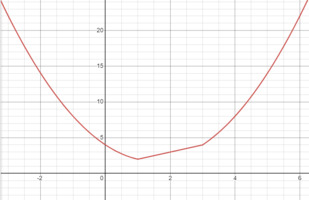You are using an out of date browser. It may not display this or other websites correctly.
You should upgrade or use an alternative browser.
You should upgrade or use an alternative browser.
How do I read this problem? (making a piecewise function continuous)
- Thread starter Integrate
- Start date
Otis
Elite Member
- Joined
- Apr 22, 2015
- Messages
- 4,589
Hi Integrate. You already understand the format for a piecewise function, yes? (The expression after each comma provides the function's domain for that piece.) Therefore, |x–2|≥1 must describe a set of x-values.How am I supposed to understand |x-2|>=1 in its place in this problem?
Thinking graphically, when we subtract one number from another, their difference can be viewed as the distance between those two points on the Real number line. The absolute value symbols around x–2 indicate that we don't care whether the difference between 2 and x is positive or negative. In other words, the expression |x–2| describes the distance between the numbers 2 and x, regardless of whether x lies to the left of 2 or to the right.
To specify that the distance |x–2| is greater than or equal to 1 defines a set of x-values. It's the set containing all numbers x that are one unit or more away from the number 2, on either side. What number is 1 unit away from 2, to the left? That's the number 1. And, all numbers to the left of 1 are more than one unit away from 2. Likewise, the number 3 is one unit away from 2, to the right, and all numbers to the right of 3 are also more than one unit away from 2.
That all's exactly what skeeter said succinctly, in math-speak.
Are you familiar with properties of absolute value? Some show us how to remove absolute value symbols (i.e., how to interpret algebraically). Here's the relevant property:
Given the form
|x| > c
We may write
x > c
OR
x < -c
(The property holds if we replace symbols > and < with ≥ and ≤.)
Hence, given the statement |x – 2| ≥ 1, we may write:
x – 2 ≥ 1
OR
x – 2 ≤ -1
Solving those two inequalities for x is another way to interpret the domain for the parabolic piece of your f(x).
[imath]\;[/imath]
Steven G
Elite Member
- Joined
- Dec 30, 2014
- Messages
- 14,603
@OtisI think that going by definition is the way to go.
|x-2| means the distance between x and 2
|x-2|>1 means that the distance between x and 2 is greater than or equal to 1. That is, x is any number that is 1 or more away from 2.
I see that you wrote exactly what I did. Sorry about that.
Otis
Elite Member
- Joined
- Apr 22, 2015
- Messages
- 4,589
You're welcome. For future readers, piecewise function f is continuous when b=-3 and c=4.Thanks everyone.

We're given the x-coordinates at each end (exclusively) of the linear piece: x=1 to the left and x=3 to the right. We're also told that the y-coordinates along the line are x+1.
Therefore, to be continuous, the left parabolic piece must terminate at (1,2) and the right parabolic piece must begin at (3,4).
Substituting the coordinates of those two points into y=x^2+bx+c yields a system of two equations:
4 = 9 + 3b + c
2 = 1 + 3b + c
We can use the Elimination Method to solve for b, by subtracting the second equation from the first:
2 = 8 + 2b
Having eliminated parameter c, we solve to get b=-3. Substituting that value for b in the system's second equation leads to c=4.
[imath]\;[/imath]

